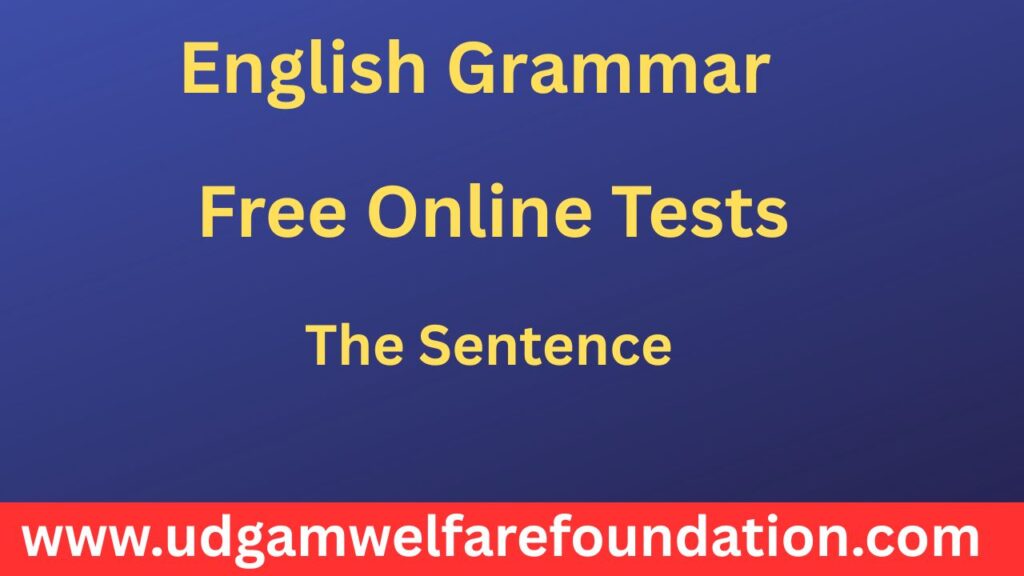Chapter: The Sentence
Discover free English study material tailored for all classes and exams like SAT and IELTS. Focus on “The Sentence” – its structure, types, and usage. Perfect for students preparing for competitive exams with comprehensive resources and clear grammar explanations available for free.
The Sentence
The Foundation of English Communication
वाक्य – अंग्रेजी संचार की आधारशिला
What Is a Sentence? / वाक्य क्या होता है?
A sentence is a complete thought expressed in words. It’s like a little package of meaning that makes sense by itself. Every proper sentence has two essential parts: a subject (who or what the sentence is about) and a predicate (what the subject is or does).
वाक्य शब्दों में व्यक्त एक पूर्ण विचार होता है। यह अर्थ का एक छोटा पैकेज है जो अपने आप में समझ आता है। प्रत्येक उचित वाक्य के दो आवश्यक भाग होते हैं: एक कर्ता (subject) (वाक्य जिसके बारे में है) और एक विधेय (predicate) (कर्ता क्या है या करता है)।
Examples / उदाहरण:
“The cat sat on the mat.” (Subject in red, Predicate in green)
“बिल्ली चटाई पर बैठी।” (लाल रंग में कर्ता, हरे रंग में विधेय)
Sentences can be short (“I run.”) or long (“After finishing my homework, I went to the park.”), but they must always express a complete idea.
वाक्य छोटे (“मैं दौड़ता हूँ।”) या लंबे (“होमवर्क पूरा करने के बाद, मैं पार्क गया।”) हो सकते हैं, लेकिन उन्हें हमेशा एक पूर्ण विचार व्यक्त करना चाहिए।
Four Main Types of Sentences / वाक्यों के चार मुख्य प्रकार
1. Declarative Sentences / विधानवाचक वाक्य
Make statements or express opinions. They end with a period (.). These are the most common type of sentences.
तथ्यों या राय व्यक्त करते हैं। इनके अंत में पूर्णविराम (.) आता है। ये सबसे सामान्य प्रकार के वाक्य हैं।
2. Interrogative Sentences / प्रश्नवाचक वाक्य
Ask questions. They end with a question mark (?). These sentences often begin with question words like who, what, when, where, why, or how.
प्रश्न पूछते हैं। इनके अंत में प्रश्नवाचक चिह्न (?) आता है। ये वाक्य अक्सर प्रश्नवाचक शब्दों (कौन, क्या, कब, कहाँ, क्यों, कैसे) से शुरू होते हैं।
3. Imperative Sentences / आज्ञावाचक वाक्य
Give commands, make requests, or offer advice. They often end with a period (.) but can end with an exclamation mark (!) for strong commands.
आदेश देते हैं, अनुरोध करते हैं या सलाह देते हैं। इनके अंत में आमतौर पर पूर्णविराम (.) आता है लेकिन मजबूत आदेश के लिए विस्मयादिबोधक चिह्न (!) भी आ सकता है।
4. Exclamatory Sentences / विस्मयादिबोधक वाक्य
Express strong emotion or surprise. They always end with an exclamation mark (!).
मजबूत भावनाएं या आश्चर्य व्यक्त करते हैं। इनके अंत में हमेशा विस्मयादिबोधक चिह्न (!) आता है।
Sentence Rules and Tips / वाक्य नियम और सुझाव
- Every sentence must begin with a capital letter. Example: “The dog barked.” not “the dog barked.”
प्रत्येक वाक्य बड़े अक्षर से शुरू होना चाहिए। उदाहरण: “The dog barked.” न कि “the dog barked.” - Every sentence must end with proper punctuation (. ? !)
प्रत्येक वाक्य उचित विराम चिह्न के साथ समाप्त होना चाहिए (. ? !) - A complete sentence must have both a subject and a verb. “Ran quickly” is not a sentence. “He ran quickly” is a sentence.
एक पूर्ण वाक्य में कर्ता और क्रिया दोनों होने चाहिए। “Ran quickly” वाक्य नहीं है। “He ran quickly” वाक्य है। - Keep your sentences clear and not too long. Break very long sentences into shorter ones.
अपने वाक्यों को स्पष्ट और बहुत लंबा न रखें। बहुत लंबे वाक्यों को छोटे वाक्यों में तोड़ें। - Match your sentence type to your purpose: Use declarative for facts, interrogative for questions, imperative for commands, and exclamatory for strong feelings.
वाक्य प्रकार को अपने उद्देश्य से मिलाएँ: तथ्यों के लिए विधानवाचक, प्रश्नों के लिए प्रश्नवाचक, आदेशों के लिए आज्ञावाचक, और मजबूत भावनाओं के लिए विस्मयादिबोधक वाक्यों का उपयोग करें।
Fill in the Blanks / रिक्त स्थान भरें
Complete each sentence with the correct punctuation mark and identify the sentence type:
प्रत्येक वाक्य को सही विराम चिह्न के साथ पूरा करें और वाक्य प्रकार पहचानें:
- Where is my backpack (Type: )
- Please pass the salt (Type: )
- I love ice cream (Type: )
- What a surprise (Type: )
- Birds can fly (Type: )
Common Sentence Errors / सामान्य वाक्य त्रुटियाँ
Error: “running in the park”
Problem: No subject (Who is running?)
Corrected: “The children are running in the park.“
त्रुटि: “running in the park”
समस्या: कोई कर्ता नहीं (कौन दौड़ रहा है?)
सुधार: “The children are running in the park.“
Error: “She go to school everyday”
Problem: Verb doesn’t agree with subject (should be “goes”)
Corrected: “She goes to school everyday.“
त्रुटि: “She go to school everyday”
समस्या: क्रिया कर्ता से सहमत नहीं है (“goes” होना चाहिए)
सुधार: “She goes to school everyday.“
Error: “what time is it”
Problem: Missing capital letter and question mark
Corrected: “What time is it?“
त्रुटि: “what time is it”
समस्या: बड़ा अक्षर और प्रश्नवाचक चिह्न गायब
सुधार: “What time is it?“
Find the Error / त्रुटि ढूंढें
Each sentence has one error. Identify and correct it:
प्रत्येक वाक्य में एक त्रुटि है। उसे पहचानें और सही करें:
- the sun is shining brightly
- Do you wants some water
- Close the window
- what a beautiful painting
- My sister and me went shopping
Remember! / याद रखें!
A sentence is a complete thought with a subject and predicate. There are four types: declarative (statements), interrogative (questions), imperative (commands), and exclamatory (strong feelings). Always start with a capital letter and end with proper punctuation!
वाक्य कर्ता और विधेय के साथ एक पूर्ण विचार होता है। चार प्रकार हैं: विधानवाचक (कथन), प्रश्नवाचक (प्रश्न), आज्ञावाचक (आदेश), और विस्मयादिबोधक (मजबूत भावनाएं)। हमेशा बड़े अक्षर से शुरू करें और उचित विराम चिह्न के साथ समाप्त करें!

